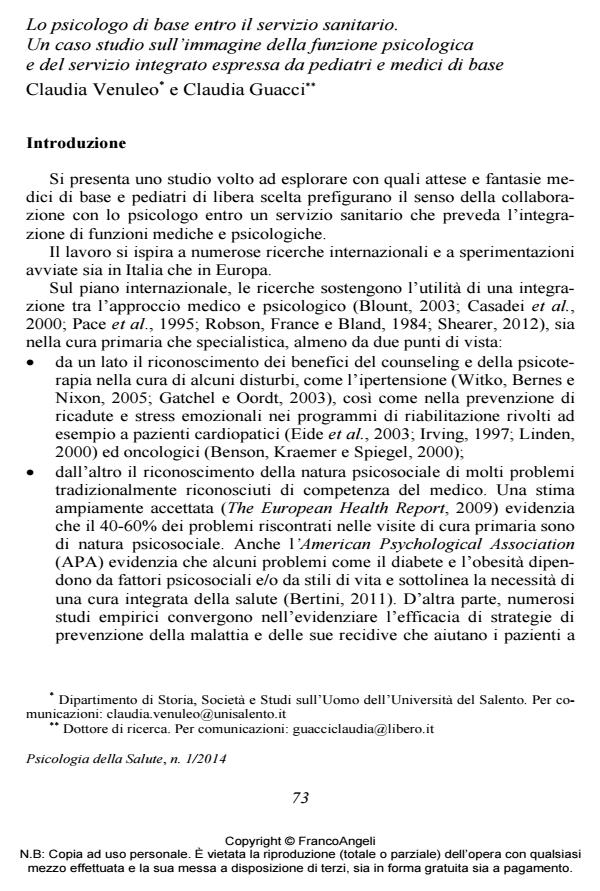The general psychologist. A case study on the image of the psychologist’s role and integrated primary care service expressed by paediatricians and general practitioners
Journal title PSICOLOGIA DELLA SALUTE
Author/s Claudia Venuleo, Claudia Guacci
Publishing Year 2014 Issue 2014/1
Language Italian Pages 25 P. 73-97 File size 1057 KB
DOI 10.3280/PDS2014-001004
DOI is like a bar code for intellectual property: to have more infomation
click here
Below, you can see the article first page
If you want to buy this article in PDF format, you can do it, following the instructions to buy download credits

FrancoAngeli is member of Publishers International Linking Association, Inc (PILA), a not-for-profit association which run the CrossRef service enabling links to and from online scholarly content.
This paper presents a study aimed at analysing the professional and service models by which paediatricians and general practitioners represent the collaboration with the psychologist within a primary care service. The research is grounded on a psychodynamic-cultural approach which acknowledges the main role of the socio-symbolic process in the way of interpreting one’s own function within a health service and the professional collaboration. A semi-structured interview was administered to 13 general practitioners and 17 paediatricians. Multidimensional analysis was applied to the transcripts: a Lexical Correspondence Analysis aimed at detecting the main dimensions of symbolization which characterize the discursive productions and a Cluster Analysis aimed at identifying the main thematic nucleus. Results allows to highlight the physicians and paediatrics commitment on an integrated primary care service and to identify what professional and service models grounds the demand of collaboration with the psychologist. Whereas the function ascribed to the service is identified with the medical one (to care the illness), psychologist is called to "contain" psychic dimensions which disturb the expected medical procedures. Whereas the function ascribed to the service is that of taking care of the user’s biopsychic- social unity, psychologist is recognized as a practitioner to whom putting in the hands the emotional component. Constraints and resources for the development of a psychological function within the integrated primary care service, as emerging by the results, are discussed.
Keywords: Psychological function, medical function, integrated service, service’s models, symbolic dimensions, thematic nucleus
- Methods and Instruments in the Study of Meaning-Making Claudia Venuleo, Tiziana Marinaci, Giulia Savarese, Annalisa Venezia, pp.169 (ISBN:978-3-031-21994-8)
- Healthcare and Culture Maria Francesca Freda, Raffaele De Luca Picione, Francesca Dicè, pp.81 (ISBN:978-1-68123-645-2)
- The Cardiac Rehabilitation Psychodynamic Group Intervention (CR-PGI): An Explorative Study Claudia Venuleo, Gianna Mangeli, Piergiorgio Mossi, Antonio F. Amico, Mauro Cozzolino, Alessandro Distante, Gianfranco Ignone, Giulia Savarese, Sergio Salvatore, in Frontiers in Psychology 976/2018
DOI: 10.3389/fpsyg.2018.00976 - Educational subculture and dropping out in higher education: a longitudinal case study C. Venuleo, P. Mossi, S. Salvatore, in Studies in Higher Education /2016 pp.321
DOI: 10.1080/03075079.2014.927847 - Unplanned reaction or something else? The role of subjective cultures in hazardous and harmful drinking Claudia Venuleo, Sara Calogiuri, Simone Rollo, in Social Science & Medicine /2015 pp.9
DOI: 10.1016/j.socscimed.2015.06.023
Claudia Venuleo, Claudia Guacci, Lo psicologo di base entro il servizio sanitario. Un caso studio sull’immagine della funzione psicologica e del servizio integrato espressa da pediatri e medici di base in "PSICOLOGIA DELLA SALUTE" 1/2014, pp 73-97, DOI: 10.3280/PDS2014-001004